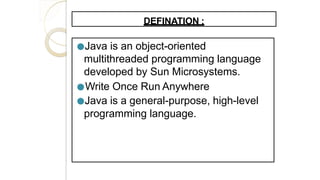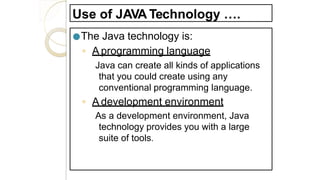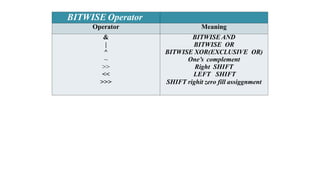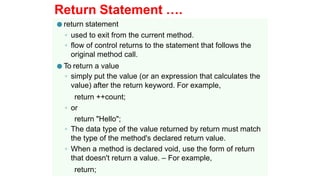Java is a general-purpose, class-based, object-oriented programming language that is designed to be portable and deliver high performance. It achieves portability by compiling Java code to bytecode that runs on the Java Virtual Machine (JVM) which is available for many hardware and software platforms. Key features of Java include being write once, run anywhere, object-oriented, platform independent, simple, secure, robust, multithreaded, and dynamic. Java applications can run on desktops, servers, mobile devices, and other platforms.





























![Main Method Class
• We define the main() method. It is essential for all Java programs. Because
the execution of all Java programs starts from the main() method.
• In other words, it is an entry point of the class. It must be inside the class.
Inside the main method, we create objects and call the methods.
• Eg:
public class Student //class definition
{
public static void main(String args[])
{
//statements
}
}](https://image.slidesharecdn.com/javaintro-220813063744-2a7c1e83/85/java-intro-pptx-30-320.jpg)
![First JAVA Program….
public class Hello
{
public static void main( String args[ ] )
{
//prints the string Welcome To JAVAProgramming! on
screen
System.out.println(“Welcome To JAVA
Programming!”);
}
}](https://image.slidesharecdn.com/javaintro-220813063744-2a7c1e83/85/java-intro-pptx-31-320.jpg)
![Steps In Running JAVA Program
● Write the previous slide’s source code as your Java
program in the Text Editor or IDE.
◦ Save your Java Program with Filename:
Hello.java
● Compiling your program
◦ in your commandTerminal window we type in
the command:
javac [filename]
◦ So in this case, type in:
javac Hello.java
◦ During compilation, javac adds a file to the
disk called [filename].class, or in this case,
Hello.class, which is the actual bytecode.](https://image.slidesharecdn.com/javaintro-220813063744-2a7c1e83/85/java-intro-pptx-32-320.jpg)
![Steps In Running JAVA Program
● Running the Program
◦ To run your Java program, type in the command:
java [filename without the extension]
◦ so in the case of our example, type in:
java Hello
◦ You can see on the screen after running the
program:
◦ " Welcome To JAV
AProgramming!"](https://image.slidesharecdn.com/javaintro-220813063744-2a7c1e83/85/java-intro-pptx-33-320.jpg)

![Explanation …..
public class Hello
{
public static void main( String args[ ])
{
●indicates the name of one method in Hello
which is the main method.
●The main method is the starting point of a
Java program.
●All programs except Applets written in
Java start with the main method.
●Make sure to follow the exact signature.](https://image.slidesharecdn.com/javaintro-220813063744-2a7c1e83/85/java-intro-pptx-35-320.jpg)
![Explanation …..
public class Hello
{
public static void main( String[] args )
{
//prints the string “Hello world” on screen
System.out.println(“Hello world”);
}
}
●The command System.out.println(), prints the text
enclosed by quotation on the screen.
●The last two lines which contains the two curly braces is
used to close the main method and class respectively.](https://image.slidesharecdn.com/javaintro-220813063744-2a7c1e83/85/java-intro-pptx-36-320.jpg)












![Variable ….
●Avariable has a:
●data type
●The data type indicates the type of value that the
variable can hold.
●name
●The variable name must follow rules for
identifiers.
●Declare a variable as follows:
●<data type> <name> [=initial value];
●●Note: Values enclosed in <> are required
values, while
●those values in [ ] are optional.](https://image.slidesharecdn.com/javaintro-220813063744-2a7c1e83/85/java-intro-pptx-49-320.jpg)
![Variable Declaration ….
public class VariableSamples {
public static void main( String[] args ){
//declare a data type with variable name
// result and boolean data type
boolean result;
//declare a data type with variable name
// option and char data type
char option= 'C';
//assign 'C' to option
//declare a data type with variable name
//grade, double data type and initialized
//to 0.0
double grade = 0.0;
}
}](https://image.slidesharecdn.com/javaintro-220813063744-2a7c1e83/85/java-intro-pptx-50-320.jpg)














![/* Program to demonstrate the addition and subtraction
of double numbers*/
class AddSubDoubles
{ public static void main (String args[])
{
double x = 7.5;
double y = 5.4;
System.out.println("x is : " + x);
System.out.println("y is : " + y);
double z = x + y;
System.out.println("x + y is : " + z);
z = x - y;
System.out.println("x - y is : " + z);
}
}](https://image.slidesharecdn.com/javaintro-220813063744-2a7c1e83/85/java-intro-pptx-65-320.jpg)








![/* Program to demonstrate Relational Operators */
class RelationalOp
{
public static void main(String args[])
{
float x = 15.0F, y = 10.65F, z = 25.0F;
System.out.println("x = "+x);
System.out.println("y = "+y);
System.out.println("z = "+z);
System.out.println("x < y is : "+(x<y));
System.out.println("x > y is : "+(x>y));
System.out.println("x == z is : "+(x==z));
System.out.println("x <= z is : "+(x<=z));
System.out.println("x >= y is : "+(x>=y));
System.out.println("y != z is : "+(y!=z));
System.out.println("y == x+z is : "+(y==x+z));
} }](https://image.slidesharecdn.com/javaintro-220813063744-2a7c1e83/85/java-intro-pptx-74-320.jpg)






![/* Program to demonstrate the boolean logical operators */
class BoolLogic
{
public static void main(String args[])
{ boolean a = true;
boolean b = false;
boolean c = a|b;
boolean d = a&b;
boolean e = a^b;
boolean f = (!a & b)|(a & !b);
boolean g = !a;
System.out.println("
System.out.println("
System.out.println("
System.out.println("
System.out.println("
a = "+a);
b = "+b);
a|b = "+c);
a&b = "+d);
a^b = "+e);
}
System.out.println(" !a&b|a&!b = "+f);
System.out.println(" !a = "+g);
}](https://image.slidesharecdn.com/javaintro-220813063744-2a7c1e83/85/java-intro-pptx-81-320.jpg)


![Operator Precedence ….
Prof.Deepak Gaikar
Operator operations Associatively
.
( )
[ ]
Access object member
Function call
Access Array element
Left to Right
- Unary minus
++ Increment
-- Decrement
! Logical negation
~ Ones complement (bitwise
Not )
Right to Left
(data type)
new
Casting
Object creation Right to Left
* Multiplication
/ Division
% Modulus
+ Addition
- Subtraction
Left to Right
+ String concatenation Left to Right
>> Right SHIFT
<< LEFT SHIFT Left to Right
>>> SHIFT righit zero fill
assiggnment](https://image.slidesharecdn.com/javaintro-220813063744-2a7c1e83/85/java-intro-pptx-84-320.jpg)
















![Example ….
int[][] numbers = {{1, 2, 3}, {4, 5, 6},{7, 8, 9}};
int searchNum = 5;
boolean foundNum = false;
searchLabel:
for( int i=0; i<numbers.length; i++ ){
for( int j=0; j<numbers[i].length; j++ ){
if( searchNum == numbers[i][j] ){
foundNum = true;
break searchLabel;
}
}
}
if( foundNum )
System.out.println(searchNum + " found!" );
else
System.out.println(searchNum + " not found!");Prof.Deepak Gaikar](https://image.slidesharecdn.com/javaintro-220813063744-2a7c1e83/85/java-intro-pptx-101-320.jpg)


![//Write a program to display the following pattern
1
01
101
0101
10101
import java.io.*;
class Pattern
{
public static void main(String args[])
{
int i,j,n,k;
Scanner br=new
System.out.print("Enter number of lines:");
n=br.nextInt());
for(i=1;i<=n;i++)
{
for(j=0;j<=i-1;j++)
{
System.out.print((i+j)%2 + " ");
}
System.out.println();
} }}](https://image.slidesharecdn.com/javaintro-220813063744-2a7c1e83/85/java-intro-pptx-104-320.jpg)
![//Write a program to determine the sum of the series
1-1/2+1/3+1/4+…….+1/n
import java.util.*;
class Sum{
public static void main(String args[])
{
int i,n,sign=1;
float sum=0;
Scanner br=new Scanner(System.in));
System.out.print("Enter value of n:");
n=br.nextInt();
for(i=1;i<=n;i++)
{
sum=sum+1.0f/i*sign;
sign=sign*-1;
}
System.out.println("Sum=" + sum);
}
}](https://image.slidesharecdn.com/javaintro-220813063744-2a7c1e83/85/java-intro-pptx-105-320.jpg)
![//Write a program to determine the sum of the series
1+1/2!+1/3!+1/4!+…….+1/n!
import java.util.*;
class Sum
{
public static void main(String args[])
{
int i,n,fact=1;
float sum=0;
Scanner br=new Scanner(System.in);
System.out.print("Enter the value of n:");
n=br.nextInt();
for(i=1;i<=n;i++)
{
fact=fact*i;
sum=sum+1.0f/fact;
}
System.out.println("Sum=" + sum);
}}
/*output*******
Enter the value of n:3
sum=1.66666666 */](https://image.slidesharecdn.com/javaintro-220813063744-2a7c1e83/85/java-intro-pptx-106-320.jpg)